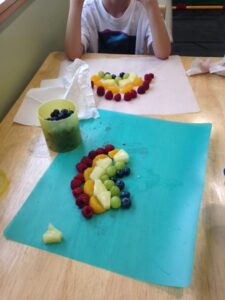A common symptom for many children with autism is food aversion, commonly known as picky eating. This type of extreme picky eating can lead to an unbalanced and unhealthy diet if a child refuses to eat foods such as fruits, vegetables and proteins.
In order to help children with food aversion improve their diet and increase the number of foods they will eat, Thompson Center occupational therapist Brittney Stevenson has developed the Picky Eaters program for patients of the Thompson Center. While the program has existed and had success for several years, Stevenson is now conducting research into exactly how effective the program is at introducing new foods to diets of children with autism.
“Often due to sensory sensitivities or the need for rigid patterns, many children with autism have difficulty adopting new foods to their diet, whether due to their temperature, texture or appearance,” Stevenson said. “Some children come into the program eating as few as 7 or 8 different foods, so it’s really important to introduce healthy options into their diet.”
The Picky Eaters program is designed for preschool-aged children and focuses on structured play activities with food. The program runs from 6-8 weeks and meets once a week at the Thompson Center, though there is an important home component to the program as well.
“The main strategy is to familiarize the children with the look, feel and taste of different foods, primarily vegetables and fruits,” Stevenson said. “Once they get comfortable with how a food feels and are convinced it won’t hurt them, they start to become more willing to eat that food more regularly.”

She found that children who participated in the program increased the number of foods they would eat from an average of 17 foods before the program to 25 foods after the program, which is an increase of nearly 50 percent. Stevenson hopes these positive and promising results will continue as she hopes to expand the program.
“Increasing a child’s diet, even by 8 different foods, can have a really positive impact on their health and the stress levels of their families,” Stevenson said. “It can be easier to go out to eat when you know there will be something on the menu that your child will eat, especially if it is a healthier option.”
Stevenson plans to continue studying the effectiveness of the Picky Eaters program in order to ensure she is providing the highest level of service to Thompson Center patients. She also hopes to present the data at the national occupational therapy conference next spring to share her successful methods with other occupational therapists from around the country.


